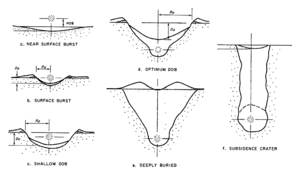Chagai-II
| Chagai-II | |
|---|---|
| Information | |
| Country | Pakistan |
| Test site | Kharan Desert |
| Period | 30 May 1998 |
| Number of tests | 1 |
| Test type | Underground tests |
| Device type | Fission |
| Max. yield | 25 kilotons of TNT (100 TJ)[1][2] |
| Test chronology | |
Chagai-II is the
The initial goals were to test the new designs of the weapon rather than studying the effects, and were different from the first tests in that they were primarily conducted by the Pakistan Atomic Energy Commission (PAEC), with the Pakistan Armed Forces engineering formations having only a supporting role.[4]
The tests detonated
Test preparations
Selection and planning
The
Safety and security required an isolated, remote, and
The weapon-testing sites were suspected to be located at

After PAEC officials clearing with Prime minister
The Special Development Works (SDW), assisted by the
After posting at the General Headquarters, Sarfraz transferred the work to Lieutenant-General Zahid Ali Akbar, the Engineer-in-Chief of the Pakistan Army Corps of Engineers.[19] The modernisation of the tests labs were undertaken by the FWO; the FWO uncredited work in the construction of the weapon-testings labs in Kharan Desert, and had supervised the entire construction on the sites along with the SDW.[20]
Final preparations were overseen by then-Lieutenant-Colonel
Test and blast yields
The Pakistan Atomic Energy Commission (PAEC) teams of scientists and engineers arrived at the site led by Dr.
The devices were
A crater now takes the place of what used to be a small hillock in the rolling desert, marking the ground zero of the nuclear test.[10] The Pakistan Atomic Energy Commission (or PAEC) had tested one or more plutonium nuclear devices, and the results and data of the devices were successful as was expected by the Pakistan's mathematicians and seismologists.[10][26]
Test teams
Pakistan Atomic Energy Commission
- Member (Technical) at PAEC.
- Hafeez Qureshi, Directorate of Technical Development (DTD)
- Irfan Burney, Director of Directorate of Technical Procurement (DTP).
- Tariq Salija, Director of the Radiation and Isotope Applications Division (RIAD).
- Muhammad Jameel, Director of Directorate of Science and Engineering Services (DSES)
- Muhammad Arshad, the Chief Scientific Officer (CSO).
- Asghar Qadir, director, Theoretical Physics Group
Pakistan Army Corps of Engineers
- Combat Engineering Division of the Pakistan Army Corps of Engineers
See also
References
- ^ a b Khan (2012, pp. 200–202)
- ^ a b Reed (2009, p. 258)
- ^ a b Planning & Development Department Government of Balochistan, Quetta (18 July 2011). "District Development Profile 2011: Kharan" (PDF). balochistan.gov.pk/. Archived from the original (PDF) on 2014-09-13. Retrieved 2015-06-10.
- ^ a b c d e Mir, Hamid. "Interview with Samar Mubarakmand". pakdef.org/. PakDef, original aired on GEO TV in 2005. Archived from the original on 2019-09-19. Retrieved 2015-06-11.
- ^ FAS. "Kharan Desert". fas.org/. Federation of American Scientists. Retrieved 2015-06-10.
- ^ "Kharan documentary". Kharan documentary. 26 January 2014. Retrieved 2015-06-10.
- ^ Pakistan 360. "Kharan Desert". pakistan360degrees.com/. Pakistan 360. Archived from the original on 2020-01-06. Retrieved 2015-06-10.
{{cite web}}: CS1 maint: numeric names: authors list (link) - ISBN 978-0-8061-3146-7.
- ^ Shahid-ur-Rehman (1999, pp. 20–21)
- ^ a b c d e f g h i Azam, Rai Muhammad Saleh (June 2000). "When Mountains Move". Rai Muhammad Saleh Azam. Karachi, Pakistan: The Nation (1999) and Defence Journal (2000). p. 1. Retrieved 2012-05-08.[permanent dead link]
- ^ Khan (2012, pp. 280–282)
- ^ a b c d e f Sublette, Carey (2 January 2002). "Historical Background: §Preparing to Build the Bomb". Nuclear Weapon Archive. Retrieved 2011-11-11.
- ^ PAEC Govt. "The Weapon-Testing Laboratories: An illustration by PAEC". Government of Pakistan release. Retrieved 2012-09-07.[verification needed]
- ^ Khan (2012, pp. 183–184)
- ^ Shahid-ur-Rehman (1999, pp. 25)
- ^ Khan (2012, pp. 184)
- ^ Shahid-ur-Rehman (1999, pp. 24–25)
- ^ Shahid-ur-Rehman (1999, pp. 26–27)
- ^ Shahid-ur-Rehman (1999, §The nuclear development under Army: General Zahid Ali)
- ^ Shahid-ur-Rehman (1999, pp. 28–30)
- ^ Shahid-ur-Rehman (1999, pp. 30–31)
- ^ Khan (2012, pp. 185–186)
- ^ Reed (2009, pp. 250–255)
- ISSN 0096-3402. Retrieved 2015-01-01.
- ^ Khan, Kamran (30 May 1998). "Interview with Abdul Qadeer Khan". The News International. Islamabad. p. 1. Retrieved 2015-06-14 – via nuclearweaponarchive.org.
- ^ "Nuclear Tests:§The Plutonium Device". Federation of American Scientists (FAS) and Pakistan Atomic Scientists Foundation (PASF). 11 December 2002. Retrieved 2011-11-11.
- Khan, Feroz Hassan (2012). Eating Grass: The Making of the Pakistan Atomic Bomb. Palo Alto, CA: Stanford University Press. ISBN 978-0804784801.
- Reed, Thomas Binnington (2009). The Nuclear Express: A Political History of the Bomb and Its Proliferation. Zenith Press. ISBN 978-0760335024.
- Shahid-ur-Rehman (1999). Long Road to Chagai. Islamabad: Printwise Publications. ISBN 9789698500009.
External links
- Chaghi-II Test on YouTube
- "Comparison of India's and Pakinstan's nuclear tests and the 30 May 1998 Afghanistan earthquake". Broadband Seismic Data Collection Center. Broadband Seismic Data Collection Center, Pakistan Atomic Scientist Federation (PASF), Pakistan Nuclear Society, Pakistan Seismic Department (PAEC), and Pakistan Meteorological Department. 23 November 2010. Archived from the original (php) on 2012-03-21. Retrieved 2011-11-11.
- "KNET recording of second Pakistani nuclear test waveforms". Broadband Seismic Data Collection Center. Broadband Seismic Data Collection Center, Pakistan Atomic Scientist Federation (PASF), Pakistan Nuclear Society, Pakistan Seismic Department (PAEC), and Pakistan Meteorological Department. 23 November 2010. Archived from the original (php) on 2012-03-21. Retrieved 2011-11-11.
